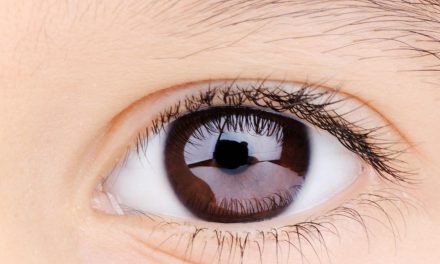How much of the medicine to lower fever should be taken?
Removing excess clothing and taking a warm bath is an excellent way to lower body temperature; however, when this is not enough, your doctor may recommend taking an antipyretic to lower your fever. In these situations, the most indicated medicine is generally Paracetamol, which can be taken up to 3 times a day, at intervals of 6 to 8 hours. Learn about other fever-reducing medications.
In the case of infants and children, fever medications should only be used under the pediatrician’s guidance since the dose varies significantly according to the weight and age of the child.
Axillary temperature
Baby lying on his back with a thermometer under his armpit
To measure an axillary temperature, your child must be able to keep his arm close to the body and not move it for 4-5 minutes.
If you use a glass thermometer, hold the top and shake it until the line is below 99 ° F (37.2 ° C). If you are using a digital thermometer, turn it on
Place the thermometer under your child’s armpit, which should be dry. The silvertip should touch the skin.
Hold the thermometer’s tip with one hand and hold your child’s arm steady with the other.
If you use a glass thermometer, wait 4 to 5 minutes before removing it. If you use a digital thermometer, leave it on until you hear the signal (usually a beep or series of beeps)
Turn off the thermometer, wash the tip with soap and warm (not hot) water, and rinse with alcohol. Dry it well
A fever is considered when the axillary temperature is above 37.3 ° C (99.1 ° F).
Ear method using a tympanic thermometer
Tympanic temperature
A child was having a temperature taken in the ear with one hand holding the ear and the other holding the thermometer to the ear.
Tympanic thermometers are NOT recommended for children under one year of age. These thermometers use infrared light to take the temperature of the eardrum. Always clean the tip of the thermometer before use and carefully follow the manufacturer’s instructions.
Gently pull on the ear, bringing it up and back. This will help straighten the ear canal and ease the path inside the ear to the eardrum.
Gently insert the thermometer until the ear canal is completely closed
Press and hold the button for one second
Remove the thermometer and read the temperature
A fever is considered when the tympanic temperature is above 38.0 ° C (100.4 ° F).
Other types of thermometer
Pacifiers digital thermometers
Digital thermometer pacifiers can be used to estimate oral temperatures in young children. Use a different method to confirm the fever. Please turn on the thermometer, put it in your child’s mouth, and wait for the signal.
If you use a digital thermometer pacifier, a temperature higher than 37.5 ° C (99.5 ° F) means that the child has a fever.
Strips for measuring temperature
Liquid crystal strips placed on the forehead are not an accurate method of measuring temperature. Use a different method to detect a fever.
Hand contact
Placing your hand on the child’s forehead or neck is not a reliable method of controlling fever. A child must have a very high temperature to detect fever this way. Always take the correct temperature using the methods explained above.
Call your doctor or other health care provider if your child:
have a fever and are less than six months old
have a fever that lasts longer than 72 hours (3 days)
is very fussy and irritable
is very sleepy and unresponsive
wheezing or coughing
have a fever, rashes, or other unusual signs
Key points
Placing your hand on the forehead is not a good way to determine if a child has a fever.
The best way to take a temperature depends on the age of the child.
Always wash the thermometers before and after taking the temperature
Call your doctor if your child has a very high temperature, has a fever that lasts three days, or has a fever and is less than six months old.
Do not use a mercury thermometer.
Temperature measurement
Send this page to a friend Print Facebook Twitter Pinterest
Measuring body temperature can help detect disease. With it, you can also monitor whether a treatment is working or not. High temperature corresponds to a fever.
How the test is performed
The American Academy of Pediatrics (AAP) advises against using glass thermometers with mercury. Glass can break, and mercury is toxic.
Electronic thermometers are almost always suggested. Temperature is viewed on an easy-to-read display. The bulb of the thermometer can be placed in the mouth, rectum, or armpit.
The mouth: place the bulb under the tongue and close your mouth. Breathe through your nose. Use your lips to keep the thermometer firmly in place. Leave the thermometer in your mouth for 3 minutes or until the device beeps.
The rectum: This method is for infants and young children. They are not able to hold the thermometer in their mouth safely. Lubricate the bulb of the rectal thermometer with petroleum jelly. Place the child face down on a flat surface or your lap. Spread your buttocks apart and insert the end of the thermometer bulb a little more than 1/2 to 1 inch (1 to 2.5 centimeters) into the anal canal. Be careful not to insert it too far. Struggling can push the thermometer further in. Remove the thermometer after 3 minutes or when the device beeps.
The armpit:
- Place the thermometer in the armpit.
- Press the arm against the body.
- Please wait 5 minutes before reading it.
Plastic strip thermometers change color to show temperature. This method is the least accurate.
Place the strip on the forehead. Read it after 1 minute while it’s there.
Plastic strip thermometers for the mouth are also available.
Electronic thermometers for use in the ear are ordinary. They are easy to use. However, some users have commented that the results are less accurate than those of bulb thermometers.
Electronic forehead thermometers are more accurate than ear thermometers, and their accuracy is similar to bulb thermometers.





